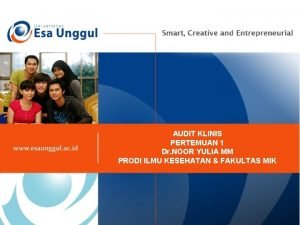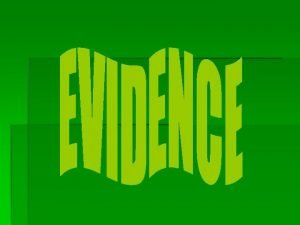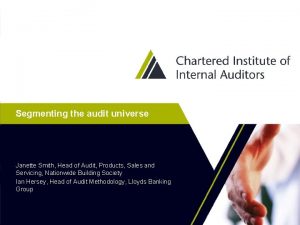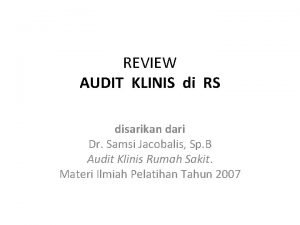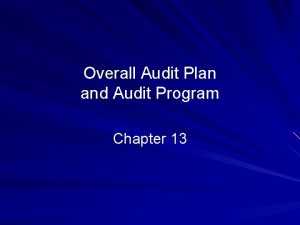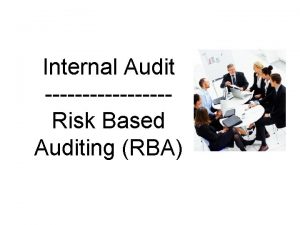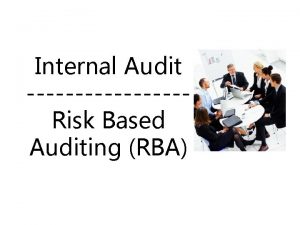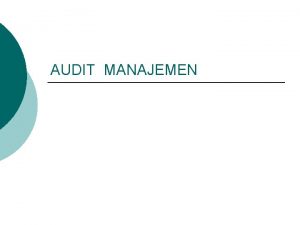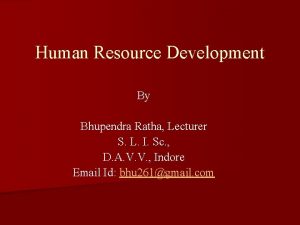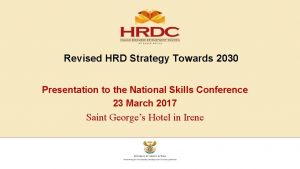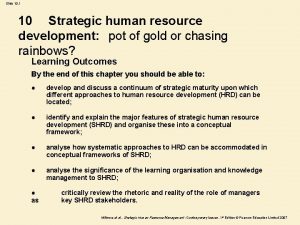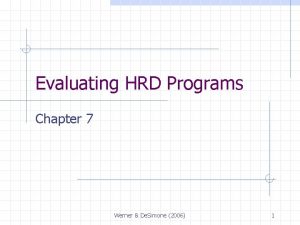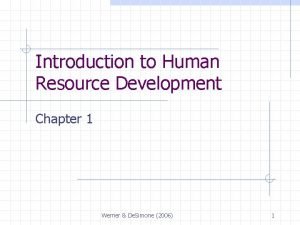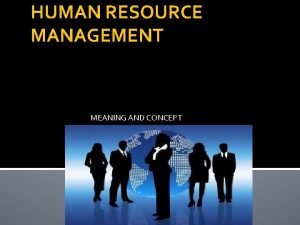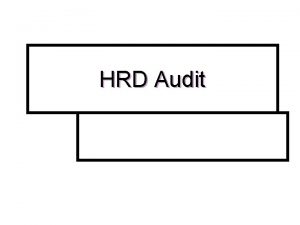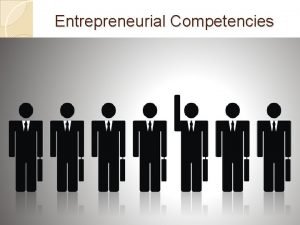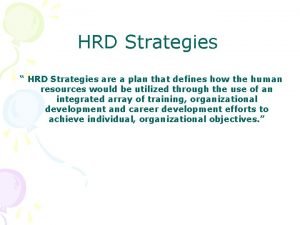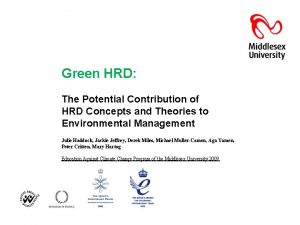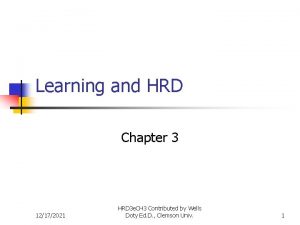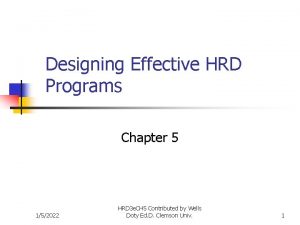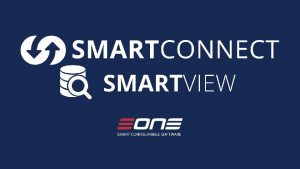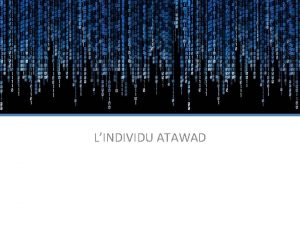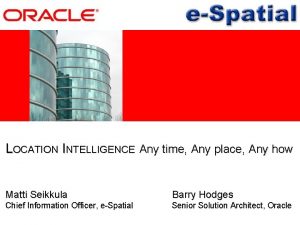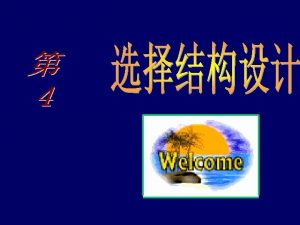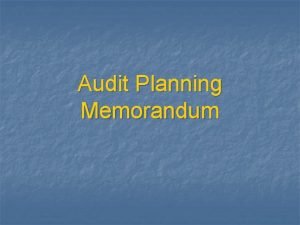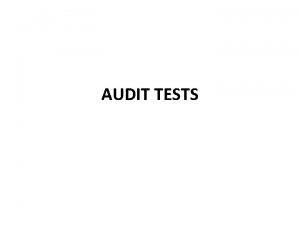HRD Competencies n n n Any HRD audit




















- Slides: 20

HRD Competencies n n n Any HRD audit is incomplete without an assessment of those involved in HRD. The HR personnel are the principal actors in the HRD field. They are expected to spend all their time studying the HR needs of the company, designing the HR strategies, aligning and realigning HRD systems to suit the strategies, implementing HR practices, etc. Their knowledge level, attitudes and skills play a critical role. The HRD audit, therefore, looks at the competency base of its staff and assesses their adequacy to suit the current and future HRD needs of the corporation. In addition to the HR staff, the line managers, top management and other strategic persons like union representatives should also possesses the right awareness, attitudes and skills. The HRD audit also attempts to assess the level of these characteristics and their adequacy for good HR. 1

CHALLENGES FOR HR CHAMPIONS n n n HRD competencies and their requirements need to be analyzed in the context of the business challenges and the role of HRD professionals in meeting them. In this context the following competitive business challenges ahead. identified by Dave Ulrich (1997 b) are worth noting: Challenge 1. Globalisation 'Globalization entails new markets, new products, new mindsets, new competencies, and new ways of thinking about business. In the future, HR will need to create models and processes for attaininig global agility, effectiveness, and competitiveness. ' (Ulrich, 1997 b: 2) 2

Challenge 2. Value chain for global competitiveness and HR services n n This is what Ulrich has to say on buildining customer-responsive organisations: 'Responsiveness includes innovation, faster decision making, leading an industry in price or value, and effectively linking with suppliers and vendors to build a value chain for customers. To support the value chain argument, research indicates that employee attitude correlates highly with customer attitude. ' (Ulrich, 1997 b: ) 3

Challenge 3. Profitability through cost and growth n n n Leveraging growth through customers involves efforts by the firm to induce customers to buy more of its products and services. Leveraging growth through core competencies involves the creation of new products and turning research knowledge into customer products. Mergers, acquisitions and joint ventures is the third growth path. The issues for HR managers arising out of these are: How can executives create a commitment to rapid growth and the culture that supports it while simultaneously controlling its costs? How can executives be sure that they hire people who can grow the business while reducing overall labour costs? 4

Continue---n n How can executives create an organisational structure that provides both the autonomy needed for growth and the discipline needed to control costs? What are the HR implications of entering new business, of leveraging core technologies that lead in to unfamiliar business and of building the intimate customer relationships that bring ever increasing percentage of customer purchase. (Ulrich, 1997 b, ] 5

Challenge 4. Capability focus n n n n 'Organisation capabilities are the DNA of competitiveness. ' (Ulrich. 1997: 10) Capabilities may be hard such as technological or soft, such as quality or organisational, speed of response. etc. The HRprofessional needs to address these in terms of: . What capabaities currently exist within the firm? . What capabilities will be required for the future success of the firm? . How can we align the capabilities with business strategies? . How can we design HR practices to design the needed capabilities? . How can we measure the accomplishment of the needed capabilities? 6

Challenge 5 Change, change and change some more n n n 'Managers, employees, and organisations must learn to change faster and more comfortably- HR prolessionals need to help their organisations to change. They need to define an Organisational model for change to disseminate that model throughout the Organisation. and sponsor its ongoing application. As cycle time gets shorter and the pace of change increases. HR professionals will have to deal with many related questions including the following: 7

Continue----n n n How do we unlearn what we have learned? How do we honour the past and adapt to the future? How do we encourage the risk taking necessary for change without putting the firm in jeopardy? How do we determine which HR practices to change for transformation and which to leave the same for continuity? How do we change the hearts and minds of every one to change? How do we change and learn more rapidly? 8

n n Challenge 6. Technology 'Managers and HR professionals responsible for redefining work at their firms need to figure out how to make technology a viable and productive part of the work setting. ' (Ulrich, 1997 b: 13) Challenge 7. Attracting, retaining, and measuring competence and intellectual capital In this fast-changing world, attracting and retaining talent becomes the battleground of competitiveness. Securing intellectual capital and developing it becomes a critical task. 9

Continue---n n The most sought after managers will possess intellectual capital to do global business. A firm's success depends upon not only the economic criteria but also on the capability to attract and retain intellectual capital. This changes the measurement criteria of a firm's success, and seeking, finding and using such measures becomes another challenge for HR professionals. 10

Challenge 8. Turnaround is not transformation n n Many organisations in the past have undertaken turnaround exercises using downsizing, business process reengineering, consolidations, restructuring, etc. They have become more profitable. Such turnaround is not transformation. Transformation involves some fundamental changes. It may involve identity changes. Creating fundamental and enduring changes may become another challenge for HR professionals. 11

COMPETENCIES NEEDED BY HR MANAGERS n n n The following is a list of competencies that the HRD professional should possess to meet the above-mentioned challenges of the corporation and society and perform his or her role effectively. HRD Professional Knowledge 1. Knowledge of HRD philosophy, policies, practices and systems 2. Knowledge of performance appraisal systems and practices 3. Knowledge of potential appraisals in theory and practice 4. Knowledge of career planning and development systems and practice 5. Knowledge of organisational diagnosis interventions, Knowledge of learning theories 7. Knowledge of training methods and systems 8. Knowledge of organisations, how they are structured and how they function 9. Knowledge of group dynamics and group functioning 10. Knowledge of inter-linkages between organisational goals, plans, policies, strategies, structure, technology, systems, people management systems, styles etc. 12

n n n 11. Knowledge of power dynamics and networks in the organisation. 12. Knowledge of organisational plans, manpower and competence requirements 13. Knowledge of social science research methods 1. 4. Knowledge of job analysis, job enrichment, job redesign and job evaluation 15. Manpower planning methods 16. Knowledge of role analysis techniques 17. Knowledge of employee-relations practices 18. Knowledge of the role of rewards 19. Knowledge of behaviour modification and attitudechange methods 20. Knowledge of quality circles 21. Knowledge of recent developments in management systems 22. Knowledge of personality theories and measurement 13

n n n n 23. Understanding of personal and managerial effectiveness 24. Knowledge of interpersonal relations and factors affecting them. 25. Knowledge of what constitutes organisational health and methods of surveying 26. Knowledge of instruments and methods to measure human behaviour 27. Personal growth and its methods 28. Knowledge of turnaround strategies 29. Knowledge of creativity and problem-solving techniques 30. Knowledge of conflict management strategies and techniques 14

HRD Professional Skills n n n 1. Influencing (communication, persuasive, assertive, inspirational and such other skills needed to influence) top management. 2. Influencing skills to influence line managers 3. Articulating the HRD philosophy and values 4. Designing skills for designing HRD systems 5. Communication skills-written (ability to communicate views, opinions, observations, suggestions, etc. , clearly to make an impact) 6. Communication skills--oral. 15

n n n n 7. Skills to monitor the implementation of HRD systems (designing questionnaires, gathering data, gathering feedback, being persuasive, and having perseverance. ) 8. Interpersonal sensitivity 9. Ability to give and receive feedback 10. Counselling skills (listening, rapport building, probing and exploring) 11. Conflict management skills 12. Ability to inspire others by arousing their values and superordinate goals 13. Interpersonal communication skills 14. Leadership and initiative 16

Conti. . n n n Creativity (ability to come up with new ideas and alternative) 16. Problem-solving skills (ability to diagnose problems and come up with various alternatives) 17. System designing skills (to design human resource information, systems, appraisal systems, manpower inventory, etc. ) 18. Task analysis/job analysis skills 19. Organisational diagnosis skills 17

Personal attitudes and values n n n n n 1. Empathy and understanding 2. Positive and helpful attitude to others 3. Faith in people and their competencies 4. Introspective attitude (a tendency to reflect about one's own self, strengths and weaknesses) 5. Openness (open to others' suggestions and likes to be open in expressing his own views) 6. Interpersonal trust 7. Proactivity 18

Continue----n n n 8. Respect for others 9. Self-confidence and faith in one's own competencies 10. Sense of responsibility 11. Sense of fairness (constant desire for objectivity and not being impressionistic) 12. Self-discipline (a desire to set an example) 19

n n n n 13. Honesty (a desire to be sincere and honest) 14. Willingness to experiment 15. Learning orientation-a tendency to treat every experience learning opportunity 16. Perseverance (not giving up easily in the event of difficulties) 17. Work motivation (a desire to be involved and work hard for. organisation) 18. Super ordination (an attitude of larger goals) 19. Empowering attitude (a tendency to respect others and willingness to empower without being over concerned about one's personal power base) 20. Stress tolerance (ability to cope with stress, frustration, hostility and suspicion) ' The above list can be used for self-assessment by the HRD professionals or for: (i) peer assessment, or (ii) identifying training and other developmental needs, or (iii) potential appraisal of candidate being considered for appointment in the HRD department. 20
 Any to any connectivity
Any to any connectivity Pertanyaan terbuka
Pertanyaan terbuka There aren't any oranges
There aren't any oranges Audit klinis adalah
Audit klinis adalah Prosedur audit bottom-up dan audit top-down
Prosedur audit bottom-up dan audit top-down Audit universe adalah
Audit universe adalah Beda audit medis dan audit klinis
Beda audit medis dan audit klinis Management audit
Management audit Overall audit plan and audit program
Overall audit plan and audit program Penyelesaian audit dan tanggung jawab pasca audit
Penyelesaian audit dan tanggung jawab pasca audit Perbedaan audit konvensional dengan audit berbasis risiko
Perbedaan audit konvensional dengan audit berbasis risiko Perbedaan audit konvensional dengan audit berbasis risiko
Perbedaan audit konvensional dengan audit berbasis risiko Konsep dasar audit
Konsep dasar audit The term audit is originated from a latin word
The term audit is originated from a latin word Hrd process
Hrd process E hrdsa
E hrdsa Hrd subsystems
Hrd subsystems Strategically oriented cycle of hrd activities
Strategically oriented cycle of hrd activities Data collection for hrd evaluation
Data collection for hrd evaluation Meaning of hrd
Meaning of hrd Need of hrm
Need of hrm



